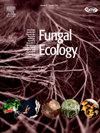未开垦草地土壤传播的植物真菌病原体的空间结构:使用新的分析工具的见解
IF 2.2
3区 环境科学与生态学
Q3 ECOLOGY
引用次数: 0
摘要
了解土壤传播的真菌植物病原体(SFPP)的空间格局与环境条件之间的联系是了解这些生物如何影响农业和耕作系统的重要第一步。然而,绝大多数SFPP空间格局研究都发生在农业系统中,并依赖于方差的基本统计测量。最近在空间分析与重采样策略相结合的统计进展允许增加对空间模式的洞察力,但需要稳健的采样设计。本文通过在美国堪萨斯州莱利县的一个未开垦草地系统中量化其在多个空间尺度上的空间格局,并将这些格局与土壤和植物变量联系起来,开始解决这一知识缺口。利用微核密度作为衡量菜籽草丰度的指标,我们发现在未开垦土壤中存在相当大的空间变异性,即使在比历史上取样的菜籽草尺度(7厘米)小得多的尺度上也是如此。我们利用点模式分析来检验密度在空间上是如何排列的,我们没有发现空间聚集的证据。相反,菜籽草的密度是随机分布的,与任何测量的土壤或植物变量都没有很强的相关性。我们的研究结果与之前的研究结果形成对比,这可能是由于我们使用了更强大的、空间明确的统计数据来检查多个尺度,以及未开垦草地系统和行作物农业系统之间的生态二分法。此外,菜豆在小尺度上的高空间变异性很难用植物或土壤变量来解释,这表明更好地了解时间变化有助于确定最影响菜豆丰度的因素。本文章由计算机程序翻译,如有差异,请以英文原文为准。
Spatial structure of a soil-borne fungal plant pathogen in an untilled grassland: insights using new analytical tools
Understanding the link between spatial patterns of soil-borne fungal plant pathogens (SFPP) and environmental conditions is an important first step to understanding how these organisms impact both agricultural and untilled systems. However, the vast majority of SFPP spatial patterns studies have occurred in agricultural systems and relied on basic statistical measures of variance. Recent statistical advancements in spatial analysis combined with resampling strategies allow increased insight into spatial patterns but require robust sampling designs. Here, we begin to address this knowledge gap for Macrophomina phaseolina by quantifying its spatial pattern at multiple spatial scales in an untilled grassland system in Riley County, Kansas, U.S.A, and relate these patterns to soil and plant variables. Using microsclerotia density as a measure of M. phaseolina abundance, we found considerable spatial variability in untilled soil, even at a scale much finer than historically sampled for M. phaseolina scales (7 cm). We utilized point pattern analysis to examine how densities are arranged in space, and we found no evidence of spatial aggregation. Rather, M. phaseolina density was randomly distributed and did not strongly associate with any measured soil or plant variables. Our findings contrast with previous work detecting aggregation of M. phaseolina likely due to our use of more robust, spatially explicit statistics that examine multiple scales as well as the ecological dichotomy between untilled grassland systems and row-crop agricultural systems. Additionally, the fact that high spatial variation of M. phaseolina over small scales was poorly explained by plant or soil variables suggests that a better understanding of temporal variation can aid in identifying factors that most influence M. phaseolina abundance.
求助全文
通过发布文献求助,成功后即可免费获取论文全文。
去求助
来源期刊

Fungal Ecology
环境科学-生态学
CiteScore
5.80
自引率
3.40%
发文量
51
审稿时长
3 months
期刊介绍:
Fungal Ecology publishes investigations into all aspects of fungal ecology, including the following (not exclusive): population dynamics; adaptation; evolution; role in ecosystem functioning, nutrient cycling, decomposition, carbon allocation; ecophysiology; intra- and inter-specific mycelial interactions, fungus-plant (pathogens, mycorrhizas, lichens, endophytes), fungus-invertebrate and fungus-microbe interaction; genomics and (evolutionary) genetics; conservation and biodiversity; remote sensing; bioremediation and biodegradation; quantitative and computational aspects - modelling, indicators, complexity, informatics. The usual prerequisites for publication will be originality, clarity, and significance as relevant to a better understanding of the ecology of fungi.
 求助内容:
求助内容: 应助结果提醒方式:
应助结果提醒方式:


